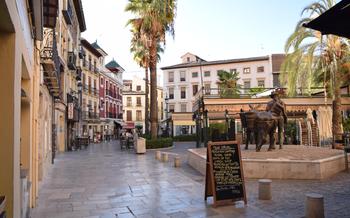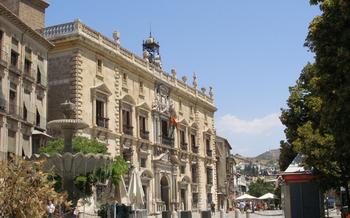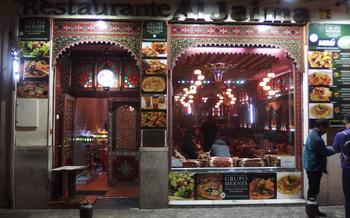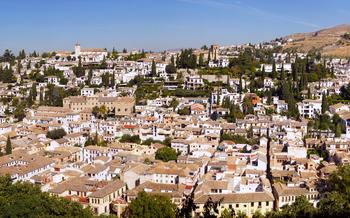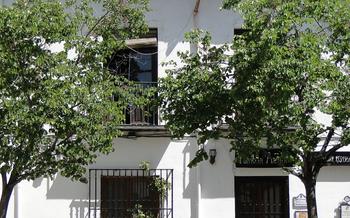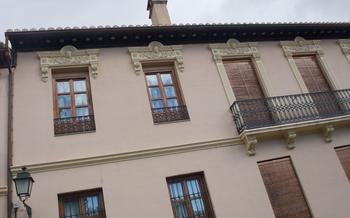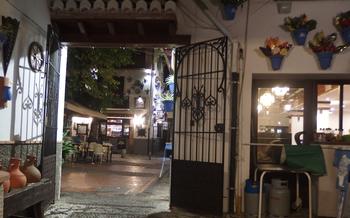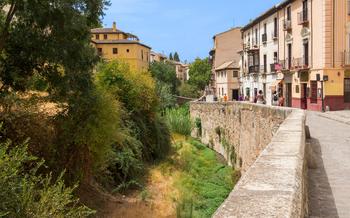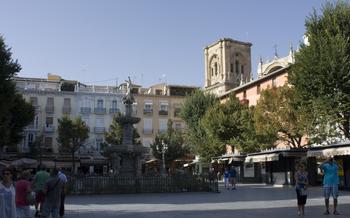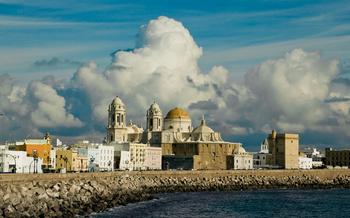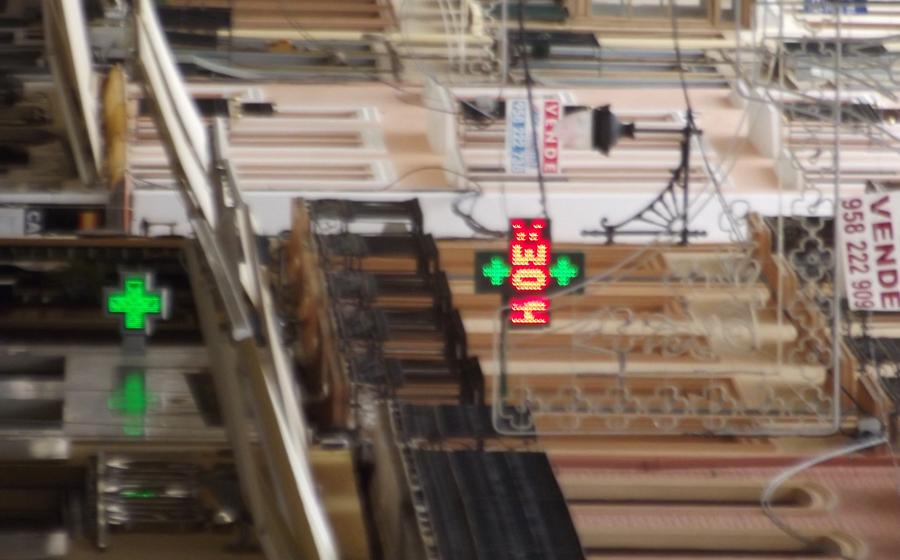
Calle Navas
- Calle Navas: A Vibrant Cultural Corner in Granada
- Strolling the Cobbled Streets
- A Culinary Paradise
- Shopping Haven
- Museo Casa de los Tiros
- Plaza Bib-Rambla
- Iglesia de San Gil y Santa Ana: A Gothic Masterpiece in Calle Navas
- The Art Scene
- Palacio de los Córdova
- Plaza Nueva: A Grand Square with Breathtaking Views
- The Narrowest Street
- Calle Elvira: A Lively Tapestry of History and Culture
- The Albaicín Quarter
- Insider Tip: Hidden Gem
Calle Navas: A Vibrant Cultural Corner in Granada
The Calle Navas, nestled in the heart of Granada, Spain, is a vibrant cultural corner that captivates visitors with its rich history, architectural marvels, and lively atmosphere. Once a flourishing trading route during the Moorish era, the street exudes an alluring charm that blends the past with the present.
Strolling along the cobbled Calle Navas, one is greeted by an array of architectural wonders that showcase the city's diverse heritage. From the intricate facades of Renaissance mansions to the remnants of Arab architecture, each building tells a story of Granada's illustrious past. Among the must-visit shops are traditional souvenir stores, artisanal workshops, and boutiques offering unique handcrafted items, making the Calle Navas a shopper's paradise.
Strolling the Cobbled Streets
Strolling along Calle Navas is a journey through time, where the echoes of history reverberate in every cobblestone. Admire the intricate facades of historical buildings, each with a story to tell. Discover hidden courtyards and plazas that exude an old-world charm. The narrow streets create a labyrinthine effect, inviting you to explore every nook and cranny.
Amidst the historical tapestry, Calle Navas pulsates with a lively atmosphere. Street performers showcase their talents, filling the air with music, laughter, and applause. Skilled artisans display their handcrafted wares, inviting you to take home a unique souvenir. Artists capture the essence of Granada in their paintings and sketches, creating a vibrant display of local talent. The neighborhood's energy is infectious, drawing visitors and locals alike to its vibrant streets.
A Culinary Paradise
Calle Navas is a foodie's paradise, with a diverse range of culinary options to satisfy every palate. Traditional Spanish tapas bars line the streets, offering a tempting array of small plates and snacks. Indulge in classic tapas like patatas bravas, croquetas, and jamón serrano, accompanied by a glass of local wine or beer.
For those seeking international flavors, Calle Navas has a selection of restaurants serving cuisine from around the world. From Italian pasta and pizza to Japanese sushi and Thai curries, there's something to suit every taste.
No visit to Calle Navas is complete without trying some of the local specialties. The region is renowned for its fresh seafood, succulent meats, and flavorful stews. Don't miss the opportunity to sample dishes like paella, gazpacho, and salmorejo, all of which showcase the culinary heritage of Granada.
As the sun sets, Calle Navas transforms into a vibrant nightlife hub. Bars and restaurants spill out onto the streets, creating a lively and social atmosphere. Enjoy a leisurely dinner, sip cocktails at a rooftop bar, or dance the night away at one of the many clubs in the area.
Shopping Haven
Calle Navas is a shopper's paradise, offering a diverse range of shopping experiences. Local boutiques and designer stores line the streets, showcasing unique and stylish fashion items. Visitors can find everything from traditional Spanish clothing to contemporary international brands.
For those seeking unique souvenirs and handcrafted items, the many handicraft shops and artisanal markets are a must-visit. Local artisans display their creations, including intricate pottery, colorful textiles, and handcrafted jewelry. Bargaining is a common practice in these markets, and visitors can often find great deals on unique souvenirs.
Calle Navas is also home to several shopping centers, offering a more modern shopping experience. These centers house a variety of retail stores, including international brands, electronics shops, and specialty stores.
When shopping in Calle Navas, it's essential to embrace the local customs and traditions. Respecting the local culture and customs is crucial to ensuring a positive and enjoyable shopping experience.
Museo Casa de los Tiros
Museo Casa de los Tiros, a testament to Granada's rich history, stands as a beacon of cultural heritage on Calle Navas. Built in the 16th century, it served as the residence of the noble Mendoza family and showcases a harmonious blend of Gothic, Renaissance, and Mudéjar architectural styles.
Within its walls, the museum houses a captivating collection of artifacts, paintings, and documents that narrate Granada's history from the Nasrid dynasty to the present day. Interactive exhibits and multimedia displays bring the past to life, offering visitors a glimpse into the city's struggles, triumphs, and cultural evolution. Guided tours provide an insightful journey through the museum's treasures, shedding light on the stories behind the exhibits.
Admission fees are nominal, ensuring that everyone has the opportunity to delve into Granada's rich legacy. Whether you're an art enthusiast, a history buff, or simply curious about this city's vibrant past, a visit to Museo Casa de los Tiros is an unforgettable experience.
Plaza Bib-Rambla
A bustling square in the heart of Granada, Plaza Bib-Rambla has stood as a witness to the city's rich history and cultural tapestry. Once a vibrant marketplace in Arab times, it retains an air of enchantment with its cobblestone streets, orange trees, and the murmur of water fountains.
The plaza is a hub of activity, with street performers entertaining the crowds, vendors selling local delicacies, and the surrounding shops and cafes inviting you to linger. It's a place to soak in the authentic atmosphere of Granada, where you can sip a café con leche, savor a traditional tapa, and watch the world go by.
Among the architectural highlights of the square is the Fuente de las Granadas (Fountain of the Pomegranates), a 16th-century marvel adorned with intricate carvings and topped by a bronze statue of a woman holding a pomegranate. The fountain symbolizes the city's abundance and fertility and is a popular meeting point for locals and visitors alike.
Plaza Bib-Rambla is also a gateway to the historic Albaicín quarter, a UNESCO World Heritage Site with its labyrinthine streets, whitewashed houses, and stunning views of the Alhambra. As you explore the surrounding area, be sure to visit the nearby Corral del Carbón, a 14th-century inn that once served as a caravanserai for merchants and travelers.
Whether you're seeking historical charm, cultural experiences, or simply a place to relax and soak in the atmosphere, Plaza Bib-Rambla is a must-visit destination in Granada.
Iglesia de San Gil y Santa Ana: A Gothic Masterpiece in Calle Navas
Amidst the vibrant streets of Calle Navas, the Iglesia de San Gil y Santa Ana stands as a testament to Granada's rich architectural heritage. This Gothic-Renaissance masterpiece, constructed in the 16th century, boasts intricate details and stunning interior frescoes that captivate visitors. Its ornate facade, featuring a blend of Gothic and Plateresque elements, invites you to step inside and explore the wonders within.
Marvel at the intricate ceiling frescoes depicting scenes from the life of Christ and the Virgin Mary, painted by renowned artists of the Granada School. Admire the magnificent altarpiece, a masterpiece of woodcarving showcasing intricate biblical scenes. The church also houses a collection of religious artifacts, including sacred sculptures, vestments, and paintings, offering a glimpse into Granada's deep-rooted Catholic traditions.
Take a guided tour to delve deeper into the history and symbolism of the church's architecture and artwork. Learn about the significance of the church in the city's religious and social life and uncover the stories behind its construction and restoration. Don't miss the opportunity to climb the bell tower for breathtaking panoramic views of Calle Navas and the surrounding cityscape.
The Art Scene
Granada's vibrant art scene pulsates with creativity and expression, captivating art enthusiasts and aficionados alike. Local art galleries, scattered throughout the city, showcase the works of talented artists, from contemporary masterpieces to traditional Andalusian paintings. The streets themselves serve as canvases for stunning murals and graffiti, adding a splash of color and intrigue to the urban landscape.
Throughout the year, Granada hosts a multitude of cultural events and festivals that celebrate the arts. The International Festival of Music and Dance, held annually in June, brings together renowned musicians and dancers from around the world, showcasing their talents on prestigious stages. The Granada Film Festival, taking place in the heart of winter, screens a diverse selection of independent films, attracting cinephiles from far and wide.
For those seeking a hands-on experience, art workshops and classes abound, offering opportunities to unleash one's creativity and learn new skills. Whether it's painting, sculpting, or pottery, there's something for every artistic inclination. Embrace the vibrant energy of Granada's art scene, and let your senses be captivated by the beauty and inspiration that surrounds you.
Palacio de los Córdova
**A Masterpiece of Architecture and History de los Córdova stands as a testament to the city's rich architectural heritage. Built in the 15th century, this magnificent palace boasts a captivating blend of Gothic, Renaissance, and Mudéjar styles, showcasing the fusion of cultures that has shaped Granada's identity.
With its intricate stone carvings, elegant arches, and serene courtyards, the Palacio de los Córdova invites visitors to journey back in time. The palace's grandeur is further enhanced by its stunning gardens, where visitors can stroll amidst lush greenery, fragrant flowers, and the tranquil sounds of water fountains.
Guided tours of the Palacio de los Córdova provide a glimpse into the lives of the noble Córdova family, who once resided within its walls. These tours showcase the palace's opulent interiors, including its grand reception halls, private chambers, and beautifully preserved artwork.
Admission fees to the Palacio de los Córdova are nominal, offering visitors an affordable opportunity to explore this architectural masterpiece. The palace is open to the public daily, allowing visitors to immerse themselves in its rich history and cultural significance at their leisure.
Whether you're an architecture enthusiast, a history buff, or simply seeking a tranquil oasis amidst the vibrant city, the Palacio de los Córdova is a must-visit destination in Granada. Its blend of architectural styles, historical significance, and serene ambiance make it a true hidden gem waiting to be discovered.
Plaza Nueva: A Grand Square with Breathtaking Views
Plaza Nueva, meaning "New Square," is a grand and majestic square located in the heart of Granada, Spain. It was built in the 16th century during the reign of Emperor Charles V and has since become a significant historical and cultural landmark in the city.
The square is surrounded by elegant Renaissance-style buildings, including the Town Hall, the Royal Chancellery, and the Captain's Palace. These buildings showcase intricate architectural details and contribute to the square's overall grandeur.
Plaza Nueva is renowned for its stunning views of the Alhambra, the iconic palace and fortress that overlooks the city. The square offers a panoramic vista of the Alhambra's majestic towers, walls, and gardens, creating a breathtaking backdrop.
The square is a popular gathering place for both locals and tourists alike. It is often used for festivals, concerts, and other cultural events. Visitors can enjoy a leisurely stroll around the square, admire the architecture, and soak in the vibrant atmosphere.
Several cafes and restaurants line the perimeter of Plaza Nueva, offering a variety of dining options. Visitors can grab a bite to eat, sip on a refreshing drink, and enjoy the lively ambiance of the square.
Whether you're a history buff, an architecture enthusiast, or simply someone who appreciates stunning views, Plaza Nueva is a must-visit destination in Granada. Take your time to explore the square, admire its grandeur, and capture some memorable photos of the Alhambra and the surrounding cityscape.
The Narrowest Street
Amidst the labyrinthine alleys of Granada, tucked away from the bustling crowds, lies a hidden gem – the Narrowest Street. This intriguing passageway, known locally as "Callejón de las Teterías," holds a unique charm that captivates visitors. With a width of barely a meter at its narrowest point, it's a true test of agility and patience to navigate through.
Legends abound surrounding the Narrowest Street. One tale suggests that it was once a secret escape route used by the Moors during the Christian reconquest of Granada. Another claims that it was a strategic passageway for soldiers to transport weapons and supplies to the nearby Alhambra fortress. Regardless of its historical origins, the Narrowest Street has become a popular attraction for tourists and locals alike.
Strolling down this narrow alleyway is an experience like no other. Its towering walls seem to close in on you, creating a sense of intimacy and mystery. The air is often filled with the enticing aromas of mint tea wafting from the traditional tea shops that line the street.
As you make your way through, be sure to look up and admire the intricate details of the buildings that flank the passageway. Many feature beautiful Arabic-style arches, ornate doorways, and colorful tiles that hint at the rich cultural heritage of Granada.
Don't forget your camera, as the Narrowest Street offers plenty of photo opportunities. Capture the unique perspective of the sky peeking through the narrow gap above, or pose for a memorable shot with friends or family as you squeeze through the tightest section of the street.
If you're lucky, you might even catch a glimpse of locals going about their daily lives, adding an authentic touch to your visit. Remember to be respectful and mindful of their privacy as you explore this hidden gem.
So, if you're looking for an off-the-beaten-path experience that will leave a lasting impression, be sure to add the Narrowest Street to your Granada itinerary. It's a place where history, culture, and charm converge, creating a truly unforgettable moment.
Calle Elvira: A Lively Tapestry of History and Culture
Calle Elvira, one of Granada's oldest and most vibrant streets, holds a special allure for travelers seeking an authentic Spanish experience. Steeped in history, it dates back to the Roman era and served as a vital thoroughfare connecting the city to the surrounding countryside. Today, Calle Elvira is a bustling hub of activity, where the past and present harmoniously blend.
Strolling along this lively street, visitors are greeted by a sensory feast. Traditional tapas bars and restaurants exude an inviting aroma, their counters laden with mouthwatering delicacies. The air reverberates with the passionate rhythm of flamenco music, spilling out from the tablaos (flamenco venues) that dot the street.
Calle Elvira is not just about gastronomy and music; it's also a treasure trove of historical landmarks. The majestic Puerta de Elvira, a remnant of the city's ancient fortifications, stands as a silent witness to Granada's rich past. The Casa del Chapiz, a 16th-century mansion, showcases exquisite Nasrid-style architecture, transporting visitors back to the era of Moorish rule.
As the sun begins to set, Calle Elvira transforms into a vibrant nocturnal haven. The street buzzes with energy as locals and tourists alike spill out onto the sidewalks, filling the air with laughter and conversation. It's the perfect time to sample the local tapas, sip on a glass of sangria, and immerse oneself in the infectious spirit of Granada.
The Albaicín Quarter
The Albaicín Quarter, a designated UNESCO World Heritage Site, stands as a testament to Granada's rich history and Moorish influence. This captivating neighborhood, nestled on a hilltop overlooking the Alhambra, transports visitors back in time with its labyrinthine cobbled streets, whitewashed houses adorned with colorful tiles, and hidden courtyards exuding an enchanting ambiance.
Strolling through the Albaicín Quarter feels like stepping into a living museum. The narrow streets, often adorned with vibrant flowers and fragrant orange trees, lead to hidden plazas and charming viewpoints that offer breathtaking panoramas of the Alhambra and the Sierra Nevada mountains.
In this enchanting quarter, the past and present intertwine seamlessly. Historical landmarks such as the Church of San Nicolás, with its stunning views of the Alhambra, and the Baños Árabes, a well-preserved Arab bathhouse, stand alongside contemporary art galleries, trendy cafes, and traditional craft shops.
The Albaicín Quarter is also renowned for its vibrant flamenco scene. Visitors can immerse themselves in the passionate rhythms and captivating dance moves of this traditional art form at one of the many tablaos, or flamenco venues, that dot the neighborhood.
Whether you're seeking historical exploration, cultural immersion, or simply a leisurely stroll through picturesque streets, the Albaicín Quarter promises an unforgettable experience, captivating the hearts and imaginations of all who visit.
Insider Tip: Hidden Gem
Venture off the beaten path to discover a hidden gem nestled within the heart of Calle Navas. Tucked away from the bustling crowds, you'll find a charming little cafe called "El Secreto de la Alhambra." This cozy establishment exudes a warm and inviting ambiance, with its rustic decor and friendly staff. Step inside and savor the aroma of freshly brewed coffee and indulge in delectable pastries, all while immersing yourself in the tranquil atmosphere. "El Secreto de la Alhambra" is a local's favorite, offering a unique and authentic experience that will leave you feeling refreshed and rejuvenated.
